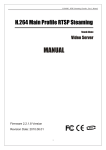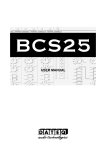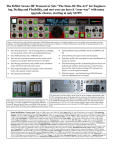Download Hawk 12 Operation Manual
Transcript
Operating Instructions and Suggestions HAWK-12 On-Air Mixer It is virtually impossible to write an operating manual for an On-Air Mixer that will satisfy everyone Every Operator, Presenter or Radio Announcer will with experience develop a unique operating technique to suit a particular presentation style, and may not agree with everything stated in this Despite the above, here are the Operating Instructions and Suggestions for the Hawk-12 On-Air Mixer, to be considered as a basic guide for beginners only The Hawk-12 is the “Mid Level” Mixer in the Elan Audio range, and is provided with 8 Stereo High Level, a Mono Telephone Channel Input and 3 Mono Microphone Level Input Channels Each Input Channel is provided with 3 Switches, OFF, ON , CUE and a Linear Slide Fader The Switches are illuminated by LED’s, and give “Clickless” control of Channel OFF, Channel ON and Channel to CUE with the Fader controlling the audio level to the Program Output or the Cue System The Switches are Interlocked electronically with only one active at a time allowing switching in any sequence, such as switching from CUE direct to ON without having to go through the OFF position Input Channels 1 to 8 are identical Stereo High Level Inputs Input Channel 9 is intended for use as a Mono Telephone Input An external Telephone Hybrid Unit, not supplied with the Hawk-12 Mixer, must be installed between the Telephone Line and Input 9 in order to record or broadcast telephone conversations A basic description of Telephone Systems Connection and Operation follows later in this Inputs 10 and 11 are the Guest Microphone Inputs, and input 12, the Announcer Microphone Input Two Interlocking 5 Position Stereo Switches (A) see page 8, not wired as supplied, are located to the Left in the riser panel and intended for a possible input line expansion to High Level Inputs 1 and 2 A Remote Start-Stop Module is provided as standard on the Hawk-12 Mixer and provides remote Start and Stop functions via the Channel On and Off Switches to Professional Source Equipment and makes operation of the mixer very easy We assume here that Gain Settings of all input channels has been adjusted correctly by the station technician to match the levels of source equipment such as CD Players, Microphones etc connected to it, and also assume the mixer has been fully installed with a suitable Monitor Amplifier, Monitor Speakers, Headphones, Off-Air Monitor Receiver etc and ready for operation First a brief discussion on Audio Levels and Audio Metering All On-Air Audio Mixers produced by Elan Audio are designed to be forgiving and easy to use and are in themselves quite tolerant of incorrect Audio Levels Nonetheless, it is very important, in order to obtain best possible Transmitted Sound Quality from the station that any audio equipment including the On-Air Mixer be operated at its correct audio levels Operating with Correct Audio Levels are particularly important to the station Audio Processor that will attempt to keep modulation levels correct It may in the process “Suck Up Noise” on low audio levels, and can on excessively high audio levels produce Distortion, unpleasant Over Compressed Squashed Sound and “Pumping Effects” 1 Reading Audio Level Meters, and operating equipment at its correct levels is not difficult, but does require some Basic Skill and Attention, as well as an appreciation of Audio Quality Unfortunately, a bewildering number of different types and styles of Audio Level Indicators are found on Domestic, Semi Professional and “On-Screen” Meters on Computer based Audio Equipment Some make some sort of sense and are quite good if you understand how to read them, while others are completely useless, including mechanical meters provided with VU Scales that are Virtually Useless For Broadcasting in Australia, there are only two recognised Audio Metering Standards One is the IEC Type II Peak Programme Meters, identical ballistics, available with two different scales IEC Type II A, BBC Type, scaled 1 to 7, and the IEC Type II B scaled –12 to +12 The other, and most common type is the VU Meter A “Real VU Meter” conforming to the ANSI Standard, whether a mechanical type or a column of LED’s is a meaningful Volume Indicator, and very pleasant to use while as mentioned above, spurious Audio Level Meters with VU Scaling are Virtually Useless (B) The Hawk-12 is provided with four Bar Graph, LED Type VU Meters, and two LED Overload indicators The VU Meters are arranged in two blocks, one block of three meters is placed to the Left and indicates Programme Output Levels, and a meter placed to the Right indicates Cue Levels The meters in the Left Block respectively indicate Left, Mono Sum and Right Channel Audio Levels The two LED Overload Indicators operate by sensing Peak Levels, and set to Flash at a level 10 dB above 0 VU to indicate whenever the Permitted Maximum Level of the system is exceeded, and possible overload occurring making the station sound bad The Centre Meter is basically a Mono Compatibility check facility and is somewhat complicated to explain, but here goes It should always, or nearly always, indicate a higher level than the Left and Right Meters showing that the Sum of Left + Right is higher than Left – Right, and that the station will sound OK on a Mono Receiver If the Centre Meter shows a lower level than the Left and Right Meters you very likely have a Phase Reversal Problem on the recorded material being played To-Air making the station sound bad on Mono Receivers This condition can be verified by pressing the Mono Check Button, described further under Monitoring The combination of the three VU Meters and two Overload LED Indicator makes it easy to operate the Hawk-12 Mixer at the correct Audio Levels The fourth VU Meter is connected to the Cue Channel allowing the operator to set the Channel Fader to correct level before switching the channel To-Air VU Meter Levels As a general guide for Microphones, adjust Channel Gain when speaking into the Microphone at a Normal Voice Level, to indicate between – 3 VU and – 4 VU, and allow the Overload Indicator to flash briefly 2 to 3 times a minute For Recorded Music, “Best Level” varies somewhat, depending on the type of music being broadcast Modern “Pop” Music is generally recorded to have a very limited “Dynamic Range” 2 Adjust Channel Gain to peak between 0 VU and + 1 VU, and allow the Overload Indicators to flash briefly 2 to 3 times a minute Country, Jazz and Blues is recorded with a reasonably wide “Dynamic Range” Adjust Channel Gain to indicate around –3 dB on normal passages, and peak to 0 VU, and allow the Overload Indicators to flash briefly 2 to 3 times a minute Classical Music is recorded with a very wide “Dynamic Range” It is very difficult to give definite directions in regard to Audio Levels for Classical Music as correct level can range from – 15 or - 20 VU on quiet passages to 0 VU or maybe even + 2 VU on loud passages As an example, the Harp produces very sharp peaks that can flash the Overload Indicator with the VU Meter reading maybe – 15 VU As a general rule, allow the Overload Indicators to flash briefly 1 or 2 times a minute on loud passages Operating ON-OFF-CUE switches and Faders Each Input Channel on the Hawk-12 Mixer is provided with a Slide Fader for Audio Level control (C1), and three Illuminated Push Button Switches (C2) controlling Channel OFF, Channel to CUE, and Channel ON to the Mixer Output via the Mixing Buses The Remote Start-Stop Module, controlled by the Channel ON and OFF Buttons, makes remote Start and Stop of Professional CD Players, other Professional Source equipment and Control of the Telephone Hybrid Unit etc extremely easy The functions of the Channel Control Buttons are as follows OFF, the Channel is switched OFF with the LED in button illuminated, indicating Channel OFF CUE, the Channel is switched to CUE with the LED in button illuminated, indicating Channel to CUE For a Stereo High Level Input Channel (HL1-HL8, T’PHONE), audio is fed to the CUE VU Meter, the CUE Speaker, and to one side of the Operators or Announcers Headphone For a Microphone Channel (GUEST1, GUEST2, ANNCR), audio is fed to the CUE VU Meter and to one side of the Operators or Announcers Headphone, With a Microphone Channel to CUE, the CUE and Monitor Speakers are Muted Level can be Pre-Set by moving the Fader to give correct level indication on the VU Meter, and also allows the operator to listen to audio before switching this To-Air ON, the Channel is switched to the Mixer Output via the Mixing Buses With a Microphone Channel switched ON, the CUE and Monitor Speakers are Muted, and a Relay Contact is closed to operate the Studio On-Air Light The Telephone Channel Input (T’PHONE) if not used with a Telephone Hybrid, can be used as a Mono High Level Input Operation of the Telephone Channel Input in conjunction with an external Telephone Hybrid Unit is described later in this Next are operational suggestions when operating the Hawk-12 On-Air as an Audio Mixer 3 Hawk-12 Operational Hints High Level Inputs All of the High Level Inputs are designed to accept Stereo Source Equipment, such as Record Players, CD Players, Mini Disk, Cassette Decks, PC Based Playback Systems, Outside Broadcast Lines, Satellite Feeds and etc Each Input Channel is either switched OFF, Switched to CUE, or Switched ON with Audio Level being controlled by the Fader The purpose of the CUE facility is • • • • Listen to an Audio Source and adjust the Audio Level before switching the channel ON To-Air Check for contents, such as verifying that the track you are about to play is the one you want Cue a Record Player or Cassette Tape to the start of recorded material Listen Off-Air to an OB Line or Satellite Feed and switch Channel ON at the right moment You can switch directly from CUE to channel ON and back again without going through OFF Switching Input Channel ON To-Air For Source Equipment, not provided with Remote Start Ensure that Fader is set to correct position, Switch Channel ON, next, Start the Source Equipment For Source Equipment, provided with Remote Start Ensure that Fader is set to correct position, Switch Channel ON, Source Equipment Starts Automatically For OB or Satellite Feeds Leave channel in CUE, ensure Fader is in correct position, listen to the programme, Switch Channel ON when wanted content starts Suggestion for material with Soft Intro Advance the Fader slightly to bring up the Soft Intro, back it off gently to correct level when intro finished Microphone Channels Designed to accept Guest and Announcers Microphones Microphone Input Channels are either switched OFF, Switched to CUE, or Switched ON with Audio Level being controlled by the Fader The purpose of the CUE facility is • • • To set the level of the Microphone Channel to be correct before Switching ON To ensure that the Microphone is actually functioning To ensure that the Microphone is not Popping or Picking Up Unwanted Noises Comments and Suggestions • • • • • • Please take note of the Audio Levels for Microphones, discussed earlier in this The Voice Level and Technique for each Announcer differ, use CUE to get Correct Level Experiment with and Practise using different Microphone Techniques Voice Levels and Microphone Techniques of Guests are unpredictable, be on guard Foam Rubber Windsocks becomes a “Health-Hazard” fairly quickly, replace them frequently Use a “Pop Killer” to prevent Popping, a worthwhile investment 4 Monitoring It is very important that the Presenter or Announcer Monitor the Station Off-Air in order to identify Audio Quality or Transmission Problems, and take the necessary action to correct these In order to perform this task properly, the following is needed • • • • • A real Receiving Antenna, properly installed, not just a Piece of Wire A Professional Off-Air Monitor Receiver such as the Elan RMR-01 A Quality Monitor Amplifier such as the Elan Audio RMA-01 A Pair of Quality Loudspeakers such as the Energy C3, available form Elan Audio A Set of Quality Headphones, Minimum AKG K44 or better, available from Elan Audio A Piece of Wire as an Antenna, feeding a Cast Off Hi-Fi Tuner, or “Ghetto Blaster”, is simply not good enough as an Off-Air Receiver, nor is the average sort of Stereo Amplifier and Loudspeakers you can pick up from your local Op-Shop for $ 20.00c, or even worse, a pair of Computer Speakers Sure, it will work, but will in all likelihood not allow you to notice subtle Audio Quality or Transmission Problems The same goes for Headphones, the $ 2.00c ones from King-Kong are simply not good enough FM Radio Broadcasting should sound as good listening Off-Air on the Studio Monitor System, as your favourite CD played at home on a Quality Stereo System Having gotten this across, we will proceed to discuss the Monitor Facilities provided on the Hawk-12 Monitor Selection (D) Three Interlocking Push Buttons, select the Monitor Source, Off-Air, EXT and PGM • • • Off-Air must be selected as the Monitor Source when Broadcasting To-Air Extension is a Spare Monitor Input and may be ignored or used to monitor an external source Program is the Output of the Mixer and used when recording etc, not when broadcasting To-Air Monitor Fader (E) Controls the Volume of the Studio Loudspeaker Monitor System Please note that the Studio Loudspeaker will Mute whenever a Microphone is switched ON or to CUE Mono Check (E1) Push Button will combine Left and Right Monitor Channels to become a Mono Signal, allowing the operator to check for Mono Compatibility of the Transmitted Audio If the Phase Fault Light is on most of the time, and the Monitor Speakers or Headphones sounds strange, Press the Mono Check Button If the Bass or Vocals almost disappears you have a Phase or Mono Compatibility problem that you unfortunately cannot do anything about, and it sounds very bad on Mono Receivers Phase and Mono Compatibility Problems are unfortunately not unusual on Amateur Recordings and cheap CD Compilations Mute (E2) Push Button will momentarily Mute the Monitor Speakers, handy not to disturb the Monitor Volume Setting if someone walks into the studio 5 Announcers Headphones Normally, the Announcers Headphones receive the Selected Monitor feed, in Stereo When CUE is selected on any Input Channel, Left Channel Headphone Monitor Feed is interrupted, and replaced with the selected CUE source allowing the Announcer to use the CUE System with Microphones switched ON A facility also exist to switch Talkback Audio into the Left Channel of the Announcers Headphone using PTT contacts, allowing Producer Talkback to Announcer with Microphones switched ON CUE Phone Level Control (F) Adjusts the Volume of the CUE channel into the Left Channel of the Announcers Headphone PGM Phones Level Control (G) Adjusts the Volume of the selected Monitor Source into the Announcers Headphone CUE Speaker Level Control (H) Adjusts the Volume of the CUE Speaker AUX Speaker Level Control (L) Adjusts the Volume of external equipment connected to Auxiliary Input (Mono) to the Cue Speaker Please note that the CUE Loudspeaker will Mute whenever a Microphone is switched ON or to CUE Other Features on the Hawk-12 Talkback Buttons (I1) Allows Talkback from the Announcers Microphone to 5 other locations provided with Talkback Facilities such as other studios, reception area, house PA etc Just ignore if such facilities are not provided in your station Talkback Level Control (I2) Adjusts Talkback Level into your CUE Speaker from other studios etc if provided On-Air, On-Delay and Dump Switches (J) These Switches are provided in the Hawk-12 to control external equipment, and as supplied, not wired to anything On-Air Switch is intended to control an external Delegation Switcher such as the Elan Audio RDS-02 Delay and Dump Switches are intended to control an external Telephone Delay System, such as the Elan Audio RTD-01 Just ignore if such facilities are not provided in your station Guest Headphone Feed Guest Headphones receive Mixer Programme Output in Mono with Level Control on an internal Trimpot The Headphone feed is accessed on internal screw terminals 6 Digital Timer (K) The Hawk-12 is provided with a Digital Timer It can be operated Manually, or linked to individual Input Channel On Switches where it will Reset and Start Counting Up, being very useful when presenting Ad-Lib Promotions or handling Phone Calls Telephone Talkback A Telephone Hybrid is a very complex 2 Wire to 4 Wire Converter It connects via 2 Wires to the General Telephone System, and is provided with a Line Output, (2 Wires) to feed into HL-8 on the Mixer, and a Line Input, (2 Wires) to be fed from the Mixer Telephone Feed The Telephone Channel, Input 9 on the Hawk-12, is provided with a special Mix Minus facility required for use as the Telephone Talkback The Telephone Hybrid is controlled from the Mixer through the Remote Start-Stop Module Operation is a bit more complex than the ordinary High Level or Microphone Inputs Here goes Normally, a Telephone Hybrid Unit is provided with a Telephone Line Loop Through, allowing a Normal Telephone to be connected across the telephone line, and be used as a normal telephone To Receive a Call and converse with the caller Switch The Telephone Channel Input to CUE, and take the call on the Telephone Hybrid You will now hear the caller through the Cue Speaker, and the Left Headphone Call, and the Caller will hear you through the Announcers Microphone The caller will not go To-Air, no need to switch the Announcers Microphone ON or to CUE To take the call To-Air Switch the Announcers Microphone ON, Fader must be in the normal position, then switch the Telephone Hybrid from CUE to ON, the caller is now On-Air The caller will hear the Announcer, and any other Input Channel that is switched ON, including the Guest Microphones, but not self due to the Mix Minus facility To make a call Use the normal telephone to dial out, when ringing, transfer the call to the Telephone Hybrid, and take the call to CUE When the call is established, you can take the call To-Air 7 8 C2 C1 4 4 CUE 5 5 HL-1 OFF ON ON CUE 0 HL-3 1 2 3 4 5 6 7 A OFF HL-2 0 6 6 0 7 7 1 HL SELECT HL SELECT 1 5 5 2 4 4 2 3 3 3 2 2 3 1 1 K HL-4 ON OFF CUE 0 HL-5 1 2 3 4 5 6 7 ON OFF CUE 0 HL-6 1 2 3 4 5 6 7 ON OFF CUE HL-7 0 1 2 3 4 5 6 7 ON OFF CUE HL-8 0 1 2 3 4 5 6 7 EVENT-TIMER START STOP RESET AUTO MAN 47 32 ON OFF CUE HYB BAL T'PHONE 0 1 2 3 4 5 6 7 ELAN AUDIO "HAWK" ON AIR MIXER ON OFF CUE 0 1 2 3 4 5 6 7 "HAWK 12" Professional Audio Mixer H T'PH HOLD 750 mm ON OFF CUE -20 ON OFF CUE GUEST-2 0 1 2 3 4 5 6 7 SUM -20 LEFT -10 -10 -7 -3 -3 -7 -2 -2 -5 -1 -1 -5 +3 +2 +1 0 +3 +2 +1 0 PHYSICAL DIMENSIONS WIDTH: 750 mm DEPTH: 360 mm HEIGHT: 145 mm GUEST-1 0 1 2 3 4 5 6 7 B O'LOAD ON OFF CUE ANNCR 0 1 2 3 4 5 6 7 RIGHT O'LOAD CUE E2 E1 -20 -10 -7 -5 -3 -2 -1 +3 +2 +1 0 MUTE MONO CHECK MONITOR 0 1 2 3 4 5 6 7 E PGM EXT OFF AIR AUX CUE CUE SPEAKER PGM PHONES CUE PHONES TALKBACK D TB-5 TB-4 TB-3 TB-2 TB-1 I1 TALKBACK DUMP ON DELAY ON AIR ANNOUNCERS HEADPHONE SOCKET H G F I2 L J Audio ELAN

















